1-Minute vs 5-Minute Figure Drawing: Quick & Dynamic Sketching
Summary
TLDRIn this figure drawing lesson, the focus is on efficiently capturing a pose within a limited time frame. The instructor emphasizes starting with the head as a proportional guide and establishing a dynamic line of action. For a 1-minute sketch, the focus is on gesture, volume, and perspective. When more time is available, the drawing is refined by adding shape, volume, and accuracy, using techniques like ellipses and boxes for three-dimensionality. The lesson highlights the importance of building drawing skills through structured practice and quick studies, which help capture movement, balance, and life in the figure.
Takeaways
- 😀 Prioritize key elements in a quick drawing, starting with the head for proportional reference.
- 😀 Use a line of action that flows from the head through the hips to guide the figure's pose.
- 😀 Begin by establishing basic volumes and ellipses to represent three-dimensionality.
- 😀 Focus on the floor contact points and use polygons to guide perspective and proportions.
- 😀 Incorporate shadows even in gesture drawings to add perspective and visual clarity.
- 😀 After a quick gesture, refine the drawing by focusing on shape and volume refinement.
- 😀 Accurate gesture drawings are essential for mapping out forms and structures in later stages.
- 😀 The purpose of figure drawing is not just to replicate reality, but to understand and interpret three-dimensional information.
- 😀 Practice figure drawing by varying time limits, progressing from short to long poses to build confidence in capturing key elements.
- 😀 Confidence in capturing gesture, weight, and movement can be developed through short studies, which add emotional content to the pose.
- 😀 With more time, further refinement, shading, and additional anatomical details can be added, but the core life of the drawing is captured early.
Q & A
What is the first step in a 1-minute figure drawing?
-The first step is to start with the head as a proportional measuring stick and establish a line of action flowing from the head through to the hips.
Why is the line of action important in figure drawing?
-The line of action serves as a guide for the overall pose and movement of the figure, helping to maintain proper proportions and fluidity in the drawing.
How do ellipses contribute to a figure drawing?
-Ellipses help convey the three-dimensionality of the form, especially in clothing and joints, by representing curved shapes that are influenced by perspective.
What is the significance of mapping out positions with a polygon on the floor?
-Mapping positions with a polygon on the floor helps guide perspective and proportion, especially in determining where the figure's feet and other key points touch the ground.
How does adding a cast shadow benefit the figure drawing?
-A cast shadow quickly shows the direction of light and perspective, which helps to establish the depth and three-dimensionality of the figure.
What should be the focus during the first minute of a figure drawing?
-The focus should be on capturing the gesture of the figure, including the line of action, proportions, and basic volumes, without getting caught up in details.
How does the approach change when more time is available for a drawing?
-With more time, the artist can refine the shapes and volumes established in the gesture phase, paying closer attention to technical details like center lines and ellipses to solidify the form.
What is the difference between 'plotting out accurate information' and 'copying the reference'?
-'Plotting out accurate information' involves interpreting and representing underlying three-dimensional structures in the drawing, while 'copying the reference' focuses on replicating surface-level details without understanding the deeper form.
Why is it important to focus on gesture drawing before volume in figure drawing?
-Focusing on gesture drawing first ensures that the flow, proportion, and emotional content of the pose are captured accurately. Volume and shape refinement come after the gesture, allowing for a more fluid and dynamic drawing.
What is the role of line quality in a figure drawing?
-Line quality in figure drawing reflects confidence and clarity. As the artist becomes more confident in the final shape, the lines become darker and more defined, indicating the finished form.
How does practicing short poses in figure drawing benefit an artist?
-Practicing short poses helps build the skill of quickly capturing essential elements like weight, movement, balance, and attitude, which are crucial for creating lively and dynamic drawings.
What does the instructor mean by saying that the life in a drawing is either there or not in the early stages?
-In the early stages of a drawing, the emotional content and vitality of the pose are captured through broad, sweeping decisions. Once these elements are established, the rest of the drawing can focus on refining details, but the initial 'life' of the pose cannot be added later.
Outlines

このセクションは有料ユーザー限定です。 アクセスするには、アップグレードをお願いします。
今すぐアップグレードMindmap

このセクションは有料ユーザー限定です。 アクセスするには、アップグレードをお願いします。
今すぐアップグレードKeywords

このセクションは有料ユーザー限定です。 アクセスするには、アップグレードをお願いします。
今すぐアップグレードHighlights

このセクションは有料ユーザー限定です。 アクセスするには、アップグレードをお願いします。
今すぐアップグレードTranscripts

このセクションは有料ユーザー限定です。 アクセスするには、アップグレードをお願いします。
今すぐアップグレード関連動画をさらに表示

ICT Mentorship Core Content - Month 08 - Defining The Daily Range

Timeframe Alignment: How To Align Timeframes For Expansion

CARA BERPIKIR SEJARAH (KONSEP BERPIKIR KRONOLOGIS, DIAKRONIK & SINKRONIK) SEJARAH INDONESIA KELAS X

ALAN BECKER - Stick Figure Animation (revamped)

ZERO To 680+ Starting From 1st AUGUST ⏩Complete Bio & Chem By December With This NEET 2025 STRATEGY

Time & Price Algorithmic Trading: Higher Timeframe Protocol
5.0 / 5 (0 votes)
